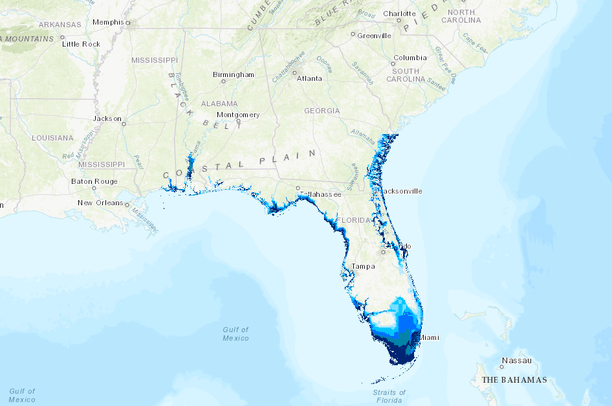US Southeast
Atlantic coast facing high threat of sea-level rise in the next 10 years
University of Central Florida
 New research shows 75 percent of the
Atlantic Coast from North Carolina to Central Florida will be highly vulnerable
to erosion and inundation from rising tides by 2030, negatively impacting many
coastal species' nesting habitats.
New research shows 75 percent of the
Atlantic Coast from North Carolina to Central Florida will be highly vulnerable
to erosion and inundation from rising tides by 2030, negatively impacting many
coastal species' nesting habitats.
The new data reflect a 30 percent
increase in highly vulnerable areas in the region since 2000, the date of previous
projections from the U.S. Geological Survey's Coastal Vulnerability Index.
The findings come from a study in
the The Journal of Wildlife Management, which was led by Betsy von
Holle, a biologist at the University of Central Florida.
Some of the coastal species at risk
include loggerhead and green sea turtles, threatened species that nest along
the shoreline and already face challenges such as an uptick in infectious
diseases.
According to the study, sea-level rise will increase the risk of erosion in about 50 percent of the nesting areas for those species by the next decade.
According to the study, sea-level rise will increase the risk of erosion in about 50 percent of the nesting areas for those species by the next decade.
"We need to know not only what areas are going to be the most affected by sea-level rise, but also those species most vulnerable to sea-level rise in order to figure out management plans for coastal species," von Holle says.
Seabirds don't fare any better,
according to the study. High-density seabird nesting habitat along the coast
for the gull-billed tern and the sandwich tern is expected to have
approximately 80 and 70 percent increased risk of erosion and inundation from sea
level rise by 2030, respectively.
Brown pelicans face somewhat less risk, the study showed, with only about 20 percent of their high-density nesting habitats having increased potential for inundation and erosion due to sea level rise. This is possibly because they preferentially nest in higher elevation areas, such as on artificial dredged material islands.
"We're surprised that there
were such big differences in the different species in terms of their
vulnerability to sea level rise," von Holle says.
"When there is erosion and
inundation during the reproductive seasons, it has large impacts on
species," she says. "A lot of these species that we studied are
threatened and endangered species, so just knowing that sea level rise will be
a threat to certain species in the future helps managers figure out how to
prioritize their management actions."
Although sea-level rise is a threat
to coastal species, experts say so are human-made structures, such as sea
walls, as they prevent the beach from naturally migrating inland. Without those
types of structures, the shoreline and coastal species could better adapt to
the rising seas, as they have done when faced with the threat in the past.
How they did it
To perform the study, the
researchers updated the U.S. Geological Survey's Coastal Vulnerability Index
for the South Atlantic Bight -- an area that extends from Cape Hatteras, North
Carolina, to Sebastian Inlet in Brevard County, Florida -- using updated
sea-level rise projection data from multiple sources.
The area includes the Archie Carr
National Wildlife Refuge in Brevard and Indian River counties, which is one of
the most important loggerhead nesting habitats in the world and the most
important green turtle nesting area in the U.S.
Using the updated data, the area of
the South Atlantic Bight considered to be highly vulnerable to the effects of
sea level rise increased from 45 percent in 2000 to a projected 75 percent by
2030.
The researchers then layered
existing geographical data about species' nesting density onto the
vulnerability projections to determine the overlap between coastal species
nesting locations and vulnerability to sea level rise by 2030.
They looked at habitat data for 11
coastal animals, including three sea turtle species, three shorebird species
and five seabird species.
The research was funded by the South
Atlantic Landscape Conservation Cooperative.